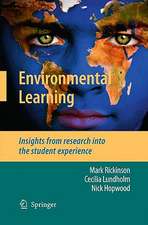Developing Models in Science Education
Editat de J.K. Gilbert, C. Boulteren Limba Engleză Hardback – 30 noi 2000
| Toate formatele și edițiile | Preț | Express |
|---|---|---|
| Paperback (1) | 950.84 lei 6-8 săpt. | |
| SPRINGER NETHERLANDS – 30 noi 2000 | 950.84 lei 6-8 săpt. | |
| Hardback (1) | 956.50 lei 6-8 săpt. | |
| SPRINGER NETHERLANDS – 30 noi 2000 | 956.50 lei 6-8 săpt. |
Preț: 956.50 lei
Preț vechi: 1166.47 lei
-18% Nou
Puncte Express: 1435
Preț estimativ în valută:
183.03€ • 191.58$ • 152.34£
183.03€ • 191.58$ • 152.34£
Carte tipărită la comandă
Livrare economică 31 martie-14 aprilie
Preluare comenzi: 021 569.72.76
Specificații
ISBN-13: 9780792366522
ISBN-10: 0792366522
Pagini: 387
Ilustrații: XI, 387 p.
Dimensiuni: 170 x 244 x 27 mm
Greutate: 0.76 kg
Ediția:2000
Editura: SPRINGER NETHERLANDS
Colecția Springer
Locul publicării:Dordrecht, Netherlands
ISBN-10: 0792366522
Pagini: 387
Ilustrații: XI, 387 p.
Dimensiuni: 170 x 244 x 27 mm
Greutate: 0.76 kg
Ediția:2000
Editura: SPRINGER NETHERLANDS
Colecția Springer
Locul publicării:Dordrecht, Netherlands
Public țintă
ResearchCuprins
Section One: On the Nature and Significance of Models.- 1. Positioning Models in Science Education and in Design and Technology Education.- 2. Science and Education: Notions of Reality, Theory and Model.- 3. Constructing a Typology of Models for Science Education.- 4. Mathematical Models in Science.- Section Two: The Development of Mental Models.- 5. Grasping Mental Models.- 6. Investigating the Role of Representations and Expressed Models in Building Mental Models.- 7. Modelling and Creativity in Design and Technology Education.- 8. Thought Experiments and Embodied Cognition.- 9. Computers and the Development of Mental Models.- Section Three: Teaching and Learning Consensus Models.- 10. Explanations with Models in Science Education.- 11. Teaching with Historical Models.- 12. Models in Explanations of Chemistry: The Case of Acidity.- 13. Models in the Explanations of Physics: The Case of Light.- 14. The Role of Models in Biotechnology Education: An Analysis of Teaching Models.- 15. Language, Models and Modelling in the Primary Science Classroom.- 16. Teaching and Learning about Chemistry and Modelling with a Computer Managed Modelling System.- 17. The Structure and Development of Science Teachers’ Pedagogical Models: Implications for Teacher Education.- 18 Challenges and Opportunities.- References.












